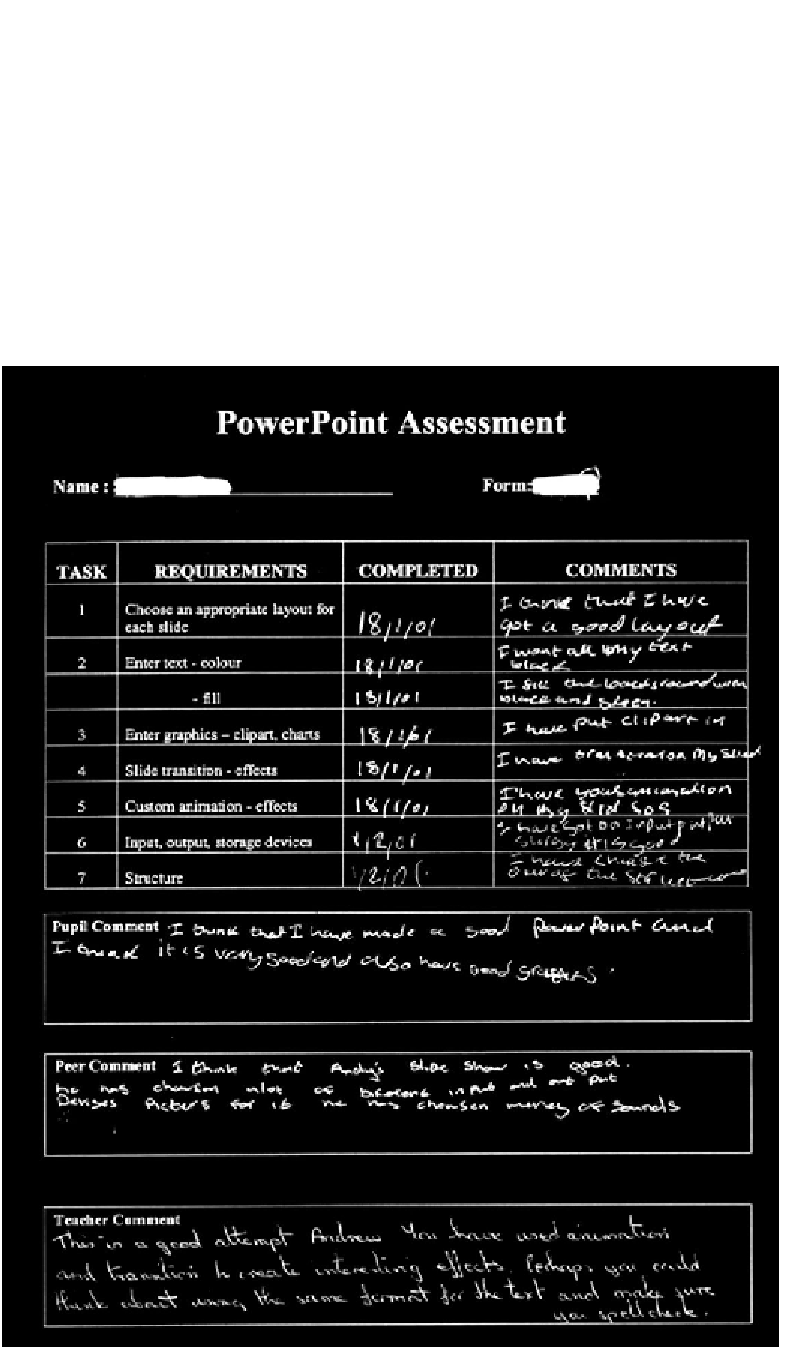Information Technology Reference
In-Depth Information
Two strategies that can help with the effective management of assessments are
peer- and self-assessment.
Peer-assessment
A good way to help a learner to understand what they need to do to succeed is to
try to assess others against a clear set of criteria. For example, you might ask pupils
to comment on how they would improve the work of others and what they thought
was best about it (
see
Figure 4.3
)
. For this to succeed criteria must be very clear and
understandable to the pupils. Time should be spent discussing the criteria, and at
first, pupils will need a lot of support, but they will get better at it and then it will
prove a very useful and effective strategy.
Straightforward or down-to-earth
Straightforward or down-to-earth
Straightforward or down-to-earth
Straightforward or down-to-earth
Straightforward or down-to-earth
by
role playing different situations. Walk
through the neighborhood with young
people identifying safe places. Take them
seriously if they ever report fee ling
scared or uncomfortable.
Straightforward or down-to-earth
Straightforward or down-to-earth
Straightforward or down-to-earth
by
by
role playing different situations. Walk
through the neighborhood with young
people identifying safe places. Take them
seriously if they ever report fee ling
scared or uncomfortable.
role playing different situations. Walk
through the neighborhood with young
people identifying safe places. Take them
seriously if they ever report fee ling
scared or uncomfortable.
Straightforward or down-to-earth
by
role playing different situations. Walk
through the neighborhood with young
people identifying safe places. Take them
seriously if they ever report fee ling
scared or uncomfortable.
Straightforward or down-to-earth
Straightforward or down-to-earth
Straightforward or down-to-earth
Straightforward or down-to-earth
by
role playing different situations. Walk
through the neighborhood with young
people identifying safe places. Take them
seriously if they ever report fee ling
scared or uncomfortable.
by
by
by
role playing different situations. Walk
through the neighborhood with young
people identifying safe places. Take them
seriously if they ever report fee ling
scared or uncomfortable.
role playing different situations. Walk
through the neighborhood with young
people identifying safe places. Take them
seriously if they ever report fee ling
scared or uncomfortable.
role playing different situations. Walk
through the neighborhood with young
people identifying safe places. Take them
seriously if they ever report fee ling
scared or uncomfortable.
by
role playing different situations. Walk
through the neighborhood with young
people identifying safe places. Take them
seriously if they ever report fee ling
scared or uncomfortable.
by
by
role playing different situations. Walk
through the neighborhood with young
people identifying safe places. Take them
seriously if they ever report fee ling
scared or uncomfortable.
role playing different situations. Walk
through the neighborhood with young
people identifying safe places. Take them
seriously if they ever report fee ling
scared or uncomfortable.
by
role playing different situations. Walk
through the neighborhood with young
people identifying safe places. Take them
seriously if they ever report fee ling
scared or uncomfortable.
by
role playing different situations. Walk
through the neighborhood with young
people identifying safe places. Take them
seriously if they ever report fee ling
scared or uncomfortable.
by
role playing different situations. Walk
through the neighborhood with young
people identifying safe places. Take them
seriously if they ever report fee ling
scared or uncomfortable.
Figure 4.3
Use of peer- and self-assessment

Search WWH ::

Custom Search